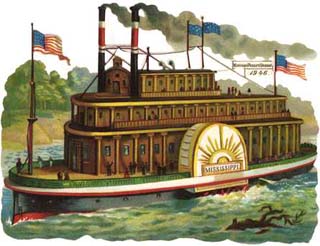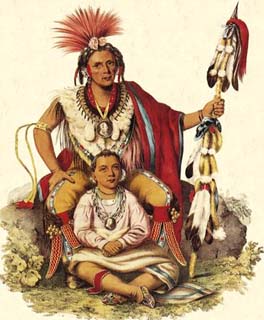The History of North American Archaeology

Introduction: Important elements in the pattern of development
of archaeology on this continent included: (1) the location of the founding
European settlements in the east; (2) regional environmental characteristics;
(3) the visibility, "allure," and accessibility of the archaeological
record in each culture area; (4) the quicker pace of development toward
the east until the 20th century.
There were four main periods in the history of North American
archaeology:
1. Period I: Incidental Discovery and Speculation:
1492-1840
A. These are the earliest but incidental reports of the most conspicuous
archaeological features by explorers, fur traders, travelers, etc.; there
were distortions but they were important because many are now destroyed.
B. The speculation was based on European myths: Atlantis, Mu, Ten Lost
Tribes of Israel, Tartars, Scythians, Welsh.
C. The Mound Builders were postulated and the search for treasure in the
mounds began.
D. Jose de Acosta (1589) suggested that Indians were from Asia but he was
only one hypothesis among many others.
E. People in this period raised basic questions: Who were the Native Americans?
Where were they from? Why were they so diverse?

2. Period II: Systematic Survey and Testing: 1840-1920
A. The roots of empirical archaeology began in natural history surveys
sponsored by national institutions, especially the Smithsonian, the American
Museum of Natural History, and Harvard University's Peabody Museum:
B. Ephrain Squire and Edwin Davis (1848, published Ancient Monuments of
the Mississippi Valley), Clarence Moore, John Wesley Powell, Frederick
Ward Putnam, and Cyrus Thomas studied sites in the Eastern United States;
Adolph Bandelier and John Wesley Powell in the Southwest. Cyrus Thomas
shattered the Mound Builder myth in the 1850s - archaeologists could then
concentrate on the Indians themselves (but this was a fading interest).
C. Formulation of culture areas occurred by William Henry Holmes and others.
D. Professionalization of the discipline began; there was a need felt
to record rapidly vanishing information; and so there was the organization
of local naturalist, historical, and scientific societies.
E. Some advances occurred regarding: (1) integration of archaeology, ethnology,
linguistics, and physical anthropology (the source of modern departments
of anthropology); (2) concern for careful description; (3) advancements
in field methods and reporting techniques; (4) increased recognition of
the great antiquity of the American Indian; and (5) growing concern for
the preservation of sites and artifacts.
3. Period III: Syntheses, Taxonomies, and Chronologies: 1920-1960
A. Many new trends emerged in the 1920s and 1930s, in part spurred by the
Great Depression and federally funded archaeology through the Works Progress
Administration (WPA).
B. Taxonomic systems: Will C. McKern came up with the Midwestern Taxonomic
System.
C. There was eventual replacement of seriation/typologica1 methods of
dating by radiocarbon in the 1950s; which provided independent, firm chronological
frameworks.
D. This was the period of the "founding fathers" in archaeology
and regional syntheses, such as Lloyd Wilford in Minnesota (at the University
of Minnesota).
E. This period also marked the appearance of professional conferences
and organizations, such as the Society for American Archaeology (1934)
and the Plains Anthropological Conference (1931).
F.The main focus of the period was historical and chronological: and involved
construction of taxonomies, area chronologies, and space-time charts; refinement
of stratigraphic and seriational procedures, and rapid adoption of new
absolute dating techniques (e.g. C-14 dating and dendrochronology).
4. Period IV: Recent Trends: 1960 - Present
A. There were two major trajectories: Processual archaeology and Cultural
Resource Management (CRM)
B. Processual archaeology (the New Archaeology) was developed by Lewis
Binford and others in the 1960s; with the motto "archaeology as anthropology";
The new focus was on the transformation of archaeological data into cultural
data, the organization of past cultural systems and their transformations
through time, and the external stimuli that triggered these changes. They
had a "behavioral" approach.
C. Cultural Resource Management (CRM) dominates North American archaeology
at present, the result of national laws, such as the National Historic
Preservation Act of 1966; Its goal is to manage and conserve America's
archaeological heritage.
D. Other trends: (1) massive growth in the numbers of professional archaeologists;
(2) increased use of statistics and computers; (3) introduction of large-scale
probability-based surveys; (4) refinement of excavation procedures (e.g.,
use of flotation, bulldozers); (5) de-emphasis on mound excavations; and
(6) growing interest in the archaeology of the historical period, both
Indian and Euro-American.
Conclusion:
A. A well-grounded understanding of North American archaeology includes
an understanding of its history.
B. Two excellent introductory surveys are Gordon Willey and Jeremy Sabloff
s (1993) A History of American Archaeology (third edition, W. H.
Freeman, N. Y.), and Bruce Trigger's (1989) A History of Archaeological
Thought (Cambridge University Press, N.Y.).